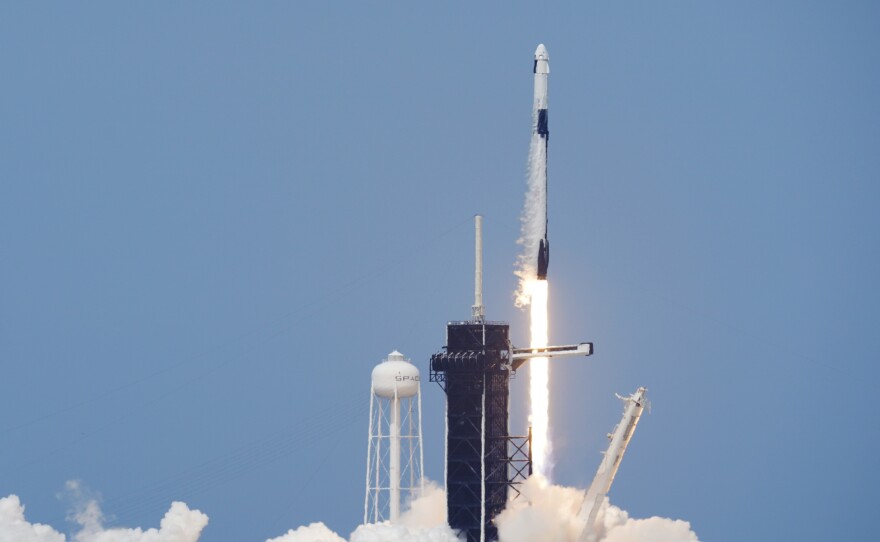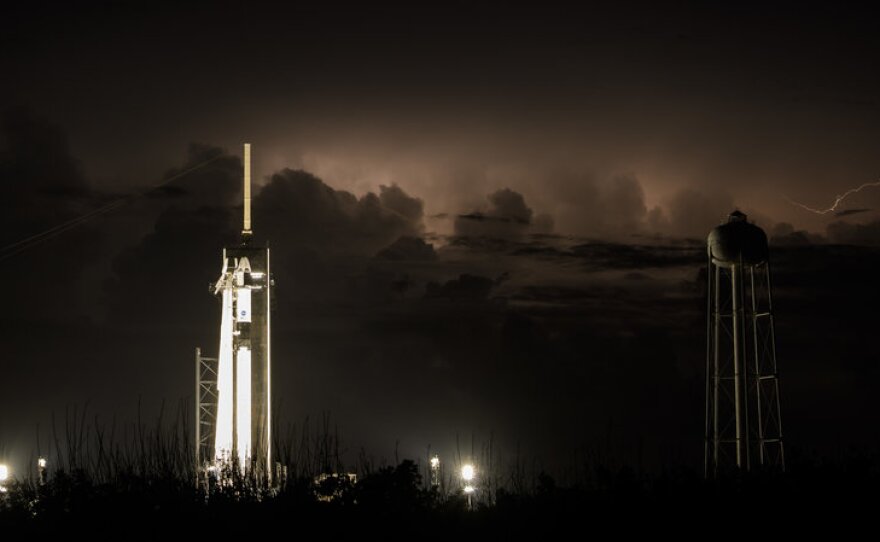
Updated at 6:55 p.m. ET
NASA astronauts are heading to space from U.S. soil for the first time in nine years, aboard SpaceX's Dragon capsule, the maiden crewed flight of the innovative spacecraft.
The mission, which is sending Doug Hurley and Bob Behnken to the International Space Station, is a bold new venture for the space agency's plan to allow commercial companies to take its astronauts into low-Earth orbit.
"Let's light this candle," Hurley said moments before ignition, borrowing words uttered by America's first astronaut, Alan Shepard, in 1961.
The duo left a fiery plume behind at Kennedy Space Center's Pad 39A at 3:22 p.m. ET as they rode SpaceX's Falcon 9 rocket toward a rendezvous with the station, which will take about 19 hours. On Wednesday, storms and a tornado warning upended a launch attempt, with the veteran space shuttle astronauts suited up and strapped into the Dragon before the mission was scrubbed.
Similar weather concerns dogged Saturday's launch and nearly forced a second delay, but NASA and SpaceX decided early Saturday that conditions were trending in the right direction. As the countdown narrowed, the weather continued to improve.
The Falcon 9 booster separated and guided itself to a successful landing on a drone ship stationed in the Atlantic. Crew Dragon separated from the rocket at 3:35 p.m. ET and entered orbit.
"It was incredible. Appreciate the great ride to space," Hurley told flight controllers as the spacecraft reached orbit.
The mission marks the first time NASA has sent astronauts into space from U.S. soil since the end of the shuttle program in 2011. For nearly a decade, it has been relying on Russian Soyuz rockets to get them there. It is also a first for SpaceX, which has ambitions of someday taking paying customers zooming around the Earth.
"It's incredible, the power, the technology," said President Trump, who was at Kennedy Space Center in Florida for the launch.
"That was a beautiful sight to see and I hope you all enjoyed it," the president said.
Speaking at a post-launch news conference on Saturday, NASA Administrator Jim Bridenstine said: "What a great day for NASA. What a great day for SpaceX. What a great day for the United States."
"I'm really quite overcome with emotion on this day, so it's kind of hard to talk, frankly," he said.
Elon Musk, the billionaire founder and CEO of SpaceX, called it "a day that I think everyone can be proud of."
"This event is something that all of humanity can get excited about," he said.
Hurley, 53, and Behnken, 49, will put the bell-shaped Dragon through its paces on the way to the station. Dragon, which on the surface resembles an updated Apollo-era command module, sports a sleek interior and oversized touchscreen controls. Its SpaceX Falcon 9 booster has been used successfully dozens of times to put satellites and space-station cargo into orbit.
The Dragon-Falcon 9 configuration is a far cry from the winged space shuttle, but the SpaceX capsule has considerable safety advantages. Unlike the shuttle, it sits on top of the rocket, therefore avoiding debris that can fall off during launch and potentially damage the spacecraft — a problem that doomed the space shuttle Columbia in 2003. The position also makes it easy to eject the capsule if the rocket itself runs into trouble.
That's not to say that SpaceX hasn't had safety issues over the years. In 2015, one of its uncrewed rockets exploded on the way to the space station. But overall, SpaceX has enjoyed a good track record in its eight years of flying cargo to the space station.
Copyright 2020 NPR. To see more, visit https://www.npr.org.






